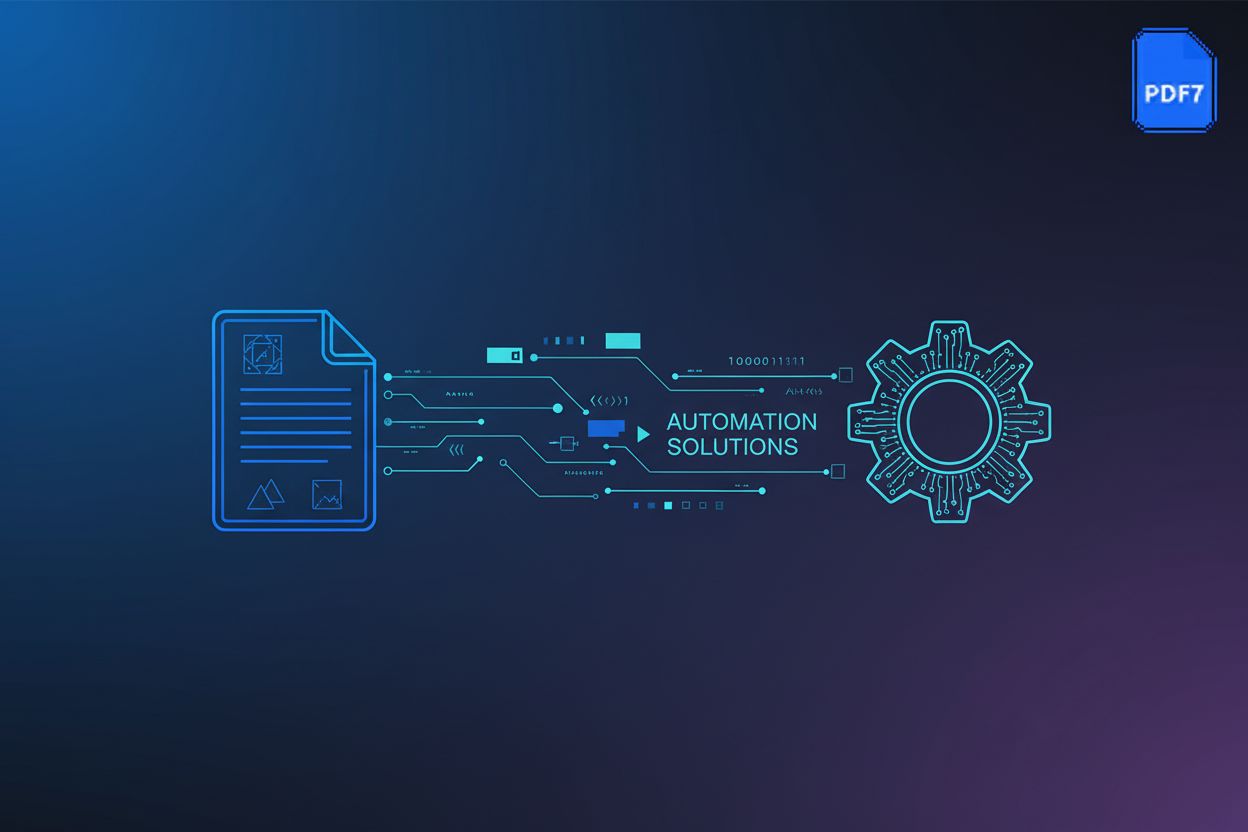Digital Document Processing: A Comprehensive Guide
Understanding Digital Document Processing
Imagine sifting through mountains of paper just to find one crucial document. Digital document processing offers a streamlined alternative, transforming how organizations handle information.
Digital document processing involves converting paper documents into digital formats and managing them electronically. (Why digitize documents — the benefits of digitization. - Adobe) Key components include scanning, which captures physical documents as digital images; Optical Character Recognition (OCR), which converts these images into machine-readable text; and document management systems (DMS), which store, organize, and retrieve digital files. It also relies on workflow automation to streamline processes.
This represents a significant evolution from traditional paper-based processes. Instead of physical archives, businesses now use digital workflows to manage information more efficiently.
Digital document processing offers numerous advantages.
- Increased efficiency: Faster document retrieval and streamlined workflows save time.
- Cost savings: Reduced paper consumption and lower printing costs translate to significant savings.
- Improved collaboration: Easy sharing and version control enhance teamwork.
- Enhanced security: Access controls and encryption protect sensitive information.
- Better accessibility: Compliance with accessibility standards ensures inclusivity.
Digital document processing has diverse applications across various sectors.
- Education: Schools manage student records and course materials digitally. For example, universities use systems to process Form I-20, a certificate of eligibility for non-immigrant student status that's crucial for international students to prove their enrollment and financial support. (Form I-20)
- Business: Companies automate invoice processing and contract management.
- Legal: Law firms organize case files and manage legal documents electronically.
- Healthcare: Hospitals digitize patient records and streamline medical billing.
- Government: Agencies archive public records and process citizen applications more efficiently.
As you can see, digital document processing offers a wide array of benefits and is used across many industries. Next, we'll explore the tools and technologies that power this transformation.
Essential PDF Processing Tools
Did you know that PDFs are opened over 2 billion times each day? To handle these files effectively, you need the right tools.
PDF Conversion Tools
Many tools exist to help you create PDFs from various file formats. You can easily convert documents from Word, Excel, or image files into PDF format. Some tools also offer batch conversion, which allows you to process multiple files simultaneously, saving time and effort. Maintaining formatting and data integrity during conversion is essential. Look for tools that ensure your documents retain their original look and feel. For example, converting a financial report from Excel to PDF should preserve the layout of tables and charts.
PDF Editing and Annotation Tools
PDF editing tools enable you to modify text, images, and other content directly within a PDF. Annotation features allow you to highlight, comment, and add notes to documents. These are useful for collaborative reviews and feedback.
PDF Security Features
Redaction capabilities are crucial for securely removing sensitive information before sharing a document. Digital signature functionality adds another layer of security by authenticating documents. Protecting sensitive information is a key concern. Password protection restricts unauthorized access to your PDFs. Encryption methods safeguard the content from being read by unintended recipients. Digital Rights Management (DRM) offers more control by restricting printing, copying, and editing. Watermarking helps identify document ownership and prevents unauthorized usage.
Choosing the right PDF processing tools ensures efficient and secure document management. Next, we'll dive into Optical Character Recognition (OCR) and its role in digital document processing.
Optimizing PDF Documents for Efficiency
Did you know that optimizing PDFs can save your organization time and money? Efficient PDFs are easier to store, share, and view, enhancing overall productivity.
File Size Reduction (Compression)
PDF compression reduces file size while maintaining acceptable quality. This is crucial for efficient storage and faster sharing.
- Lossy compression permanently removes some data. It's ideal for images where slight quality loss is acceptable.
- Lossless compression reduces file size without losing any data. This is better for text and graphics where quality is critical.
Tools optimize images by reducing resolution or converting them to more efficient formats. Removing unnecessary elements, such as unused fonts or embedded objects, further reduces file size. Smaller file sizes translate to lower storage costs and quicker transmission times.
Performance and Archiving Optimization
Optimizing PDFs involves several strategies beyond simple compression. These techniques ensure documents are efficient and user-friendly.
- Removing duplicate fonts and embedded objects streamlines the file. This reduces redundancy and lowers the overall file size.
- Optimizing for web viewing ensures fast loading times. This enhances the user experience when viewing PDFs online.
- Linearization enables progressive downloading. Users can view the first page while the rest of the document loads in the background.
- Ensuring PDF/A compliance is vital for long-term archiving. PDF/A is an ISO standard that guarantees the document will be accessible in the future.
Accessibility Considerations
Creating accessible PDFs ensures that everyone, including users with disabilities, can access the information.
- Adding alternative text for images is essential. This provides a text description of the image for screen readers.
- Ensuring proper document structure and tagging is crucial. Tags define the reading order and help assistive technologies navigate the document.
- Compliance with WCAG (Web Content Accessibility Guidelines) and Section 508 standards ensures inclusivity. These standards provide specific guidelines for making digital content accessible.
Optimizing PDFs enhances efficiency and accessibility. Next, we'll explore Optical Character Recognition and its role in digital document processing.
Document Workflow Automation
Imagine documents flowing seamlessly through your organization, automatically routed and approved without a single manual touch. That's the power of document workflow automation.
Setting Up Automated Workflows
Setting up automated workflows streamlines how documents are reviewed and approved. This involves defining rules and conditions that dictate the path a document takes. For example, an invoice exceeding a certain amount can be automatically routed to a manager for approval. Electronic signatures expedite the signing process. Instead of printing, signing, and scanning documents, digital signatures allow for secure and legally binding approvals. This significantly reduces turnaround times and improves efficiency.
Integration and Data Exchange
Integration with existing document management systems is crucial. Automated workflows should seamlessly interact with your current systems to avoid data silos and ensure a smooth flow of information. Connecting document processing tools with CRM (Customer Relationship Management), ERP (Enterprise Resource Planning), and other business applications creates a unified information ecosystem. This integration ensures that data flows seamlessly between systems, eliminating manual data entry and reducing errors.
APIs (Application Programming Interfaces) facilitate seamless data exchange. APIs enable different software systems to communicate and share data, automating tasks such as updating customer records or generating reports.
Automating Data Extraction and Entry
Automating data extraction and entry is another key benefit. Instead of manually inputting data from documents into systems, OCR (Optical Character Recognition) technology can automatically extract and populate fields, saving time and improving accuracy.
Benefits of automation include:
- Reduced manual intervention, freeing up employees for more strategic tasks.
- Faster turnaround times, accelerating business processes and improving customer satisfaction.
- Improved accuracy, minimizing errors associated with manual data entry and routing.
- Enhanced compliance, ensuring documents adhere to regulatory requirements and internal policies.
Consider a retail company that integrates its document processing system with its CRM. When a customer places an order, the system automatically generates an invoice, updates the customer's purchase history in the CRM, and triggers the shipping process. This end-to-end automation streamlines operations and enhances the customer experience.
As you can see, document workflow automation can significantly improve efficiency and accuracy. Next, we'll explore PDF security features and how they protect sensitive information.
Advanced Techniques in Digital Document Processing
Did you know that advanced techniques can transform how you interact with digital documents? Let's explore how Optical Character Recognition (OCR) and text processing ai are revolutionizing document workflows.
Optical Character Recognition (OCR)
OCR technology converts scanned images and PDFs into searchable and editable text. This is especially useful for documents that start as physical copies.
- Converting scanned images and PDFs into searchable and editable text is a foundational step. It allows you to interact with documents that were previously inaccessible to search functions.
- Improving OCR accuracy with advanced algorithms ensures that the conversion is reliable. Modern algorithms can handle various fonts, handwriting styles, and image qualities.
- Using OCR to extract data from forms and invoices automates data entry. For example, businesses can automatically pull information from invoices into accounting systems, saving time and reducing errors.
- Applications in document archiving and information retrieval are vast. Libraries and archives use OCR to make historical documents searchable online.
Artificial Intelligence (AI) in Document Processing
ai takes document processing to the next level by analyzing and understanding the content within documents. It automates tasks that previously required manual effort.
- Using ai to analyze and understand document content allows for more than just simple text recognition. ai can identify context, sentiment, and key themes.
- Automating document classification and categorization helps organize large volumes of files. For instance, a legal firm can use ai to automatically categorize documents by case type, relevance, and confidentiality level.
- Extracting key information and insights from text provides valuable data for decision-making. Market research firms can analyze customer feedback from surveys and reports to identify trends and preferences.
- Applications in legal discovery, market research, and customer service are transforming these fields. ai can quickly sift through thousands of documents in legal discovery, provide insights from market data, and improve customer service interactions through sentiment analysis.
Imagine a healthcare provider using text processing ai to analyze patient feedback forms. The ai identifies recurring complaints about long wait times and suggests solutions to improve patient satisfaction. Or, consider a retail company using OCR to digitize handwritten customer surveys, then employing ai to extract sentiment and identify product trends.
These advanced techniques are enhancing document processing across industries. Next, we'll dive into PDF security features and how they protect sensitive information.
Choosing the Right Digital Document Processing Solution
Selecting the right digital document processing solution can feel like navigating a maze. But with a clear understanding of your needs and the available options, you can streamline your workflows and boost efficiency.
Assessing Your Needs
Begin by pinpointing your specific document processing requirements. Consider the types of documents you handle, such as invoices, contracts, or reports. Evaluate the volume and complexity of your documents. Do you process hundreds of simple forms or a few intricate legal agreements each day?
Also, think about your budget and technical resources. Can you afford a comprehensive enterprise solution, or do you need a more affordable, user-friendly option? Determine the level of integration needed with existing systems, such as your CRM or ERP.
Evaluating Solutions and Implementation
Next, compare the features, pricing, and support options of various solutions. Read reviews and testimonials from other users to get insights into their experiences. Request demos and trials to test the software firsthand.
Ensure the solution complies with industry standards and regulations, such as HIPAA for healthcare, which mandates strict privacy and security for patient health information, or GDPR for data privacy, which sets rules for how personal data is collected, processed, and stored. Consider factors like ease of use, scalability, and security features.
Develop a detailed plan for implementing the new solution. Provide comprehensive training to employees on how to use the software effectively. Monitor the system's performance and make adjustments as needed. According to the University of Maryland, College Park, it can take up to two weeks to receive an I-20 form once you submit your checklist, demonstrating the importance of efficient document processing in educational institutions.
Ensure data security and compliance throughout the implementation process. Establish clear protocols for data handling and access control. Regularly update the software to address security vulnerabilities and maintain optimal performance.
Choosing the right digital document processing solution involves careful assessment and planning. By following these steps, you can find a solution that meets your needs and improves your organization's efficiency. Next, we'll explore PDF security features and how they protect sensitive information.
Streamline Your PDF Tasks with PDF7
Unlock the full potential of your PDFs with tools that simplify complex tasks. PDF7 provides a comprehensive online solution for all your document needs, making digital document processing more efficient and accessible.
PDF7 offers a robust suite of tools for managing PDF documents directly from your browser. It eliminates the need for multiple software installations by providing a centralized platform for various tasks.
PDF Conversion and Management
- Convert various file formats to PDF: Easily transform documents from Word, Excel, JPG, and other formats into PDF. This ensures compatibility and easy sharing across different platforms.
- Edit, compress, and organize PDFs: Modify text, images, and layouts, reduce file sizes for efficient storage, and arrange pages to create well-structured documents.
Free PDF Tools for Essential Tasks
Accessibility is key, and PDF7 delivers with a range of free tools that require no downloads or installations. This makes it convenient for users to perform essential PDF tasks on any device.
- Merge PDFs, rotate pages, remove unwanted content, and extract specific sections: Combine multiple documents, adjust page orientation, eliminate unnecessary information, and isolate key parts of a PDF.
- Enhance your text with built-in tools: Improve writing with features like the Paraphrasing Tool, Translator, Summarizer, Grammar Checker, and Proofreader, ensuring clear and professional communication.
Security and Accessibility Features
Security and accessibility are paramount in digital document processing. PDF7 ensures your documents are protected and available wherever you need them.
- Protect your sensitive documents: Add password protection to restrict unauthorized access and use the unlocking feature to regain access when needed.
- Access PDF tools from any device: With cloud-based accessibility, users can manage their PDFs from anywhere, ensuring flexibility and convenience.
- Optimize documents for sharing and storage: Compression and optimization features reduce file sizes, making documents easier to share and store without sacrificing quality.
By offering a comprehensive set of tools, PDF7 https://pdf7.app/ streamlines PDF tasks and enhances document management.





